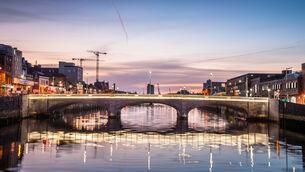Clodagh Finn: Why isn’t Irish anti-slavery campaigner Mary Ann McCracken better known?

Forgotten Irishwoman Mary Ann McCracken who found slavery so abhorrent she refused to take sugar, the product of slave labour, in her tea. Picture by John Gibson ©National Museums NICollection Ulster Museum.
It is astonishing that Belfast-born social reformer and abolitionist Mary Ann McCracken is not a household name, particularly in a year when there has been so much discussion of slavery and its enduring legacy.
In July, the 250th anniversary of her birth went by with hardly a whisper but there is still time to celebrate the long life of a woman whose motto was: “It is better to wear out than to rust out.”
Aged 88, just 17 days from her 89th birthday, she was still distributing anti-slavery leaflets to emigrants leaving Belfast docks.
“There she was – the little frail, bent figure – standing by the gangway with her leaflets as the jostling crowds made their way on board. It was the only service she could still render to the cause of liberty,” Mary McNeill notes in her biography, , 1770–1866, reissued last year.
The image of this lone figure on the docks, bonneted and bespectacled, warning emigrants that America “considered the land of the great, the brave may more properly be styled the land of the tyrant and the Slave” is particularly evocative, but it represents only one aspect of her many-sided life.
She was also a student of politics, a businesswoman and a campaigner for equality.
Sadly, if she is remembered now it is as the woman who wept as she accompanied her more famous brother, United Irishman Henry Joy McCracken, to the scaffold in 1798.
Yet, she too campaigned for a united Ireland and spent the next six decades of her life championing a range of causes from Catholic emancipation to promoting Irish music and the Irish language.
She supported female suffrage and through the Poor House Ladies Committee helped to educate children and fought to abolish the use of climbing boys in chimney sweeping.

Yet, like so many other women in Irish history, her life’s work has been defined by her relationship to men.
In his 1968 book, Sweethearts of the Irish Rebels, Seamus G Kelly went so far as to dismiss her as a forlorn spinster in love with her brother’s best friend, Thomas Russell.
The evidence? When asked to describe him, Mary Ann McCracken wrote: “Thomas Russell was a model of manly beauty who you could not pass on the street without being guilty of the crime of looking him directly in the face and turning your head to have a look at the receding figure.”
Kelly thought only a woman in love could have written such a letter. (Any woman with eyes in her head could have written such a letter!)
Thankfully, women’s voices – in all their wonderful expressiveness – have started to emerge through letters, new archives and, perhaps most important of all, a willingness to look at history through a female lens.
Just last year, Clifton House in Belfast, where Mary Ann McCracken did much of her philanthropic work, established a foundation in her name to bring her life to the attention of a wider audience.
While their summer plans to commemorate her birth in July 1770 were scuppered by Covid-19, the virus has also brought one unexpected advantage – a boom in Zoom lectures, which means it is now easier than ever to ‘visit’ the city’s former Poor House and hear about a woman who deserves more prominence.
Had you made the virtual trip last week, you would have heard historian Dr Margaret Ward and Aaron McIntyre, Archive and Heritage Development Officer of Clifton House, speak about retrieving women’s voices from the past and one in particular, that of Mary Ann McCracken.
“In her correspondence,” McIntyre said, “we see a really strong character. She read the Northern Star, the United Irishman newspaper, which was in direct competition with her own family newspaper, the Belfast Newsletter [Her grandfather set up the Newsletter]. She held her own opinions and was not afraid to share them with her brothers.”
Their contributions were considered ephemeral or unimportant and subsequently erased. Without their letters, we would know little of their work or lives.
As Dr Ward emphasises: “Correspondence is vital but, unfortunately, so many people think that their ageing aunt or granny couldn’t possibly have had an interesting life. So much of value was simply discarded, unread, on their deaths.”
As we venture on through the decade of centenaries, it is more important than ever to hear women’s voices.
As Dr Ward puts it: “Adding women to the writing of history ‘complicates the narrative’ and deepens our understanding of the past. Women’s testimonies challenge the ‘boy’s own’ masculinist narrative that we’ve been used to in the past.”
We have seen that ‘complicated’ narrative most recently with new research about violence against women perpetrated by both sides during the War of Independence and the Civil War.
One particularly chilling example, noted by Dr Ward, was a letter written by a woman known only as Mary M who described her rape, at the hands of so-called republicans, during the Civil War.
“Could any pen describe what I have gone through?” she wrote, describing how she became pregnant after “one brute satisfied his duty passion on me”.
Her story might have been forgotten had her letter to archbishop Edward Byrne asking for money to pay for the private adoption of her son not been discovered in the archives of the Archdiocese of Dublin by UCD historian Dr Lindsey Earner-Byrne.
It is wonderful, then, to see Mary Ann McCracken taking her place in the limelight.
Her 250th birthday party might not have come off but next January, the foundation set up in her honour will be officially launched by British historian David Olusoga.
Meanwhile, a map has just been published which encourages visitors to walk in Mary Ann’s footsteps in Belfast.
That is a simple but very engaging way of writing women into history and it’s one that might be used elsewhere to celebrate other Irish women, such as Cork campaigner Isabel Jennings and Limerick woman Susanna Fisher, who fought against slavery.
Both women raised money and organised speaking engagements for Frederick Douglass while he toured Ireland 175 years ago.
There have been calls to mark the anniversary of the famous escaped slave with a statue or a street bearing his name. Worthy projects, both, but we might also draw inspiration from the Mary Ann McCracken project and consider a Douglass tour of Ireland map.
Mary Ann herself would be on it, of course, as it’s almost certain she heard him speak in Belfast.
We just need to ensure that all the other Irishwoman who did so much to help his anti-slavery campaign also make the cut.











